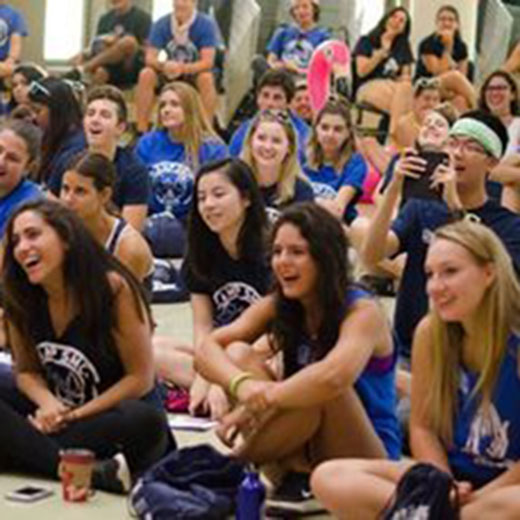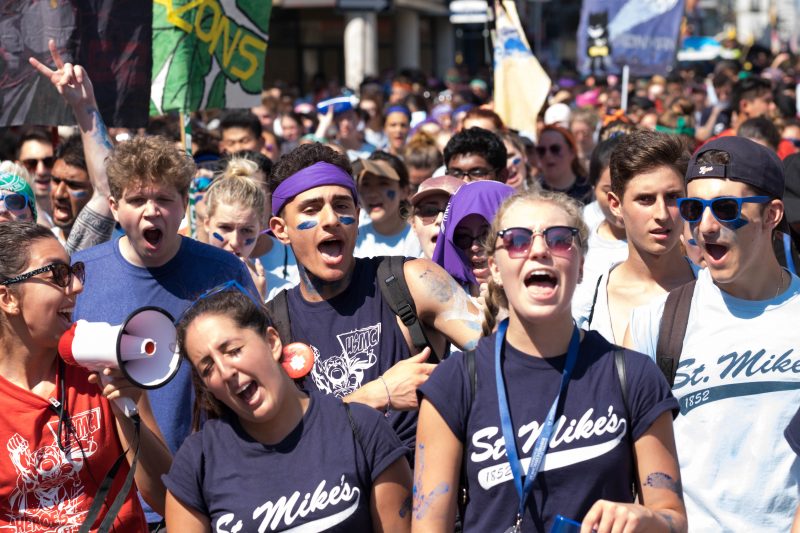“The most important part of SMC Orientation is showing students that they belong here.”
-Alessia Baptista and Sophia Poulimenakos, Orientation Coordinators 2022
Alessia Baptista and Sophia Poulimenakos are this year’s Orientation Coordinators. Alessia is a fourth-year student studying English with minors in French and Anthropology, while Sophia is a fifth year studying Political Science with minors in Sociology and Music History. Orientation holds a special place in their hearts as they both have been a part of orientation since their first day at SMC.
When we were told we’d been given the green light to have a fully in-person Orientation this year you could not contain our excitement. Both of us were orientees in the pre-pandemic Orientations (in 2018 for Sophia and 2019 for Alessia) but neither of us knew that this amazing event that changed our lives would be held in an entirely different way when we chose to get involved. When we signed up as leaders in 2020, the world turned upside down, and the need to find community became even greater. Orientation is special: we would argue it’s the most special and important event any university has to offer. It presents an opportunity like no other to show our new students that SMC is their corner of the campus: a corner that belongs to them and will always be there for them. In times like these, when community building is more valuable than ever, we did not take the responsibility of planning the first in-person Orientation in two years lightly.

If you asked each of us what the most important part of Orientation is, we wouldn’t say the countless nights planning our events schedule, calling numerous vendors, or even the days we spend contemplating the smallest things (we’re overthinkers; what can we say?). The most important part of Orientation is ensuring each student knows that they belong here. No matter where they come from or who they are, SMC has a place for them.
But it’s only so much to make such a bold statement; we had already found our places within this community, so this year we made it a top priority to implement everything we could to ensure everyone can see themselves reflected in this community.
We started small, right down to our team. Our main concern became who would be the first people welcoming our students to SMC, and we wanted everyone to see themselves reflected in student leadership. We took a lot into consideration, from our younger staff taking on larger roles to ensuring not only those willing to scream at the top of their lungs in front of a crowd would apply for roles, and even encouraging first-time student leaders into our team. Our first step in creating a community where students feel they belong is representing them at the onset. When a team looks and acts like the people they are leading, others feel like leadership not only welcomes them, but needs them to function to their fullest capacity.

Our next step became looking wider than our own community, even wider than our own country. With both of us being domestic and commuter students, Toronto life came more naturally to us, but that wasn’t the case for many of our international friends. We started holding debriefing sessions with our staff, mainly targeting our international staff members, asking them what we could do better and, honestly, what we weren’t considering, having always lived in Ontario. Resources were huge, from small things such as where to buy groceries or “what even is Presto card?” to much larger things like buying an apartment in the city, applying for a SIN number, or finding mental health and community resources in the city when students felt alone.
We came to the collective conclusion that SMC Orientation was not doing enough to highlight how hard it is to move your whole life to a new country many incoming students had never seen before. The solution was to implement tours of Toronto, international student workshops built right into our Orientation programming, and a Cultural Club Showcase exceeding what SMC can provide. Designed by international students for international students, we granted our team the ability to take the lead on creating the programming they knew would have helped them. With this, our hope was that it would give our international population the chance to even have just a little more ease in their transition.
Of course, Orientation is not without tradition, and the green light to have everything in person meant we got to bring not only new ideas to the forefront but also old ones that our older staff had come to miss. With our theme this year being SMC: Treasure Island, the opportunity to bring back events became even easier. With campus tours disguised as campus-wide scavenger hunts, Zumba parties in the Quad encouraging exercise for their treasure hunt adventure ahead of them, and a Formal at the Hockey Hall of Fame showcasing operation “find the crowned gem” – in this case finding the Stanley Cup and taking a picture with it. All this work to find the most important treasure of them all – friendship! Okay, not just friendship, but the chance to be crowned the winner of the O-Cup and have their team’s name immortalized at SMC forever. This year’s theme is reflective of the very thing we wanted to portray for this year’s Orientation, on a treasure hunt you may feel like you’re on your own towards the goal of finding “treasure” – but what you find along the way is people who want to help you and support you and your goals.
SMC Orientation has always been about team building and finding community, but this year we wanted to make sure that we understand that a community is only as strong as each individual within it. The art of planning the first fully in-person Orientation in two years comes down to combining the new with the old–much like our staff and students–and it becomes our job to ensure everyone finds their place within the place where we found ours.
Read other InsightOut posts.

